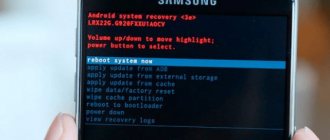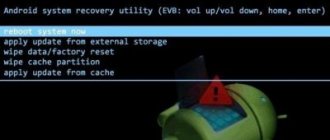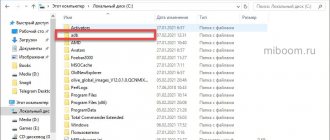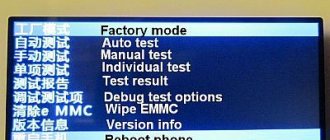" Programs
Evgeny Opanasenko 12/27/2017
Every smartphone user has at least once heard the concept of recovery , let's figure out what it is , in what cases the mode should be used and how to launch it on your device.
Contents:
- Definition
- Recovery in Android
- How to get to Android
- How to manage menus in Android?
- Explanation of mode names
- Stock and Custom Recovery. What is the difference?
- How to install a custom version on Android?
- Recovery on Windows Phone
- Recovery in Windows 10
- Recovery on Mac OS
Definition
Recovery (recovery mode) is factory software that is included in mobile and desktop operating systems. The purpose of the work is to restore the operation of the gadget, back up data, and configure system parameters of the phone/computer.
By logging into Recovery you can:
- Recover device errors;
- Flash your smartphone or reinstall the OS on your computer;
- Get superuser rights.
Let's take a closer look at how it works in all popular operating systems for smartphones and computers.
Ways to enter Recovery mode
On the device itself
Standard method. The principle of entering Recovery Mode is the same for all devices - when you turn it on, you need to hold down several buttons. Most often this is volume up, but the following options may also occur:
- Samsung - power on + volume up + Home.
- LG - power on + volume down.
- Google Nexus, HTC - power on + volume down, then tap Recovery.
- Certain Lenovo, Motorola models - power on + volume up + “Home”.
- Sony - power button, after double vibration, hold down the volume up.
If for some reason you cannot enter Recovery Mode using standard means, try checking the instructions. The listed combinations are valid in almost all cases and will work both to enter the standard recovery menu and the custom one. In addition, you can run it even when the tablet does not boot or the system freezes.
If you have root rights, you will need the Terminal Emulator application installed (https://play.google.com/store/apps/details?id=jackpal.androidterm). After installation, you will need to enable superuser rights and enter two commands: first su and then reboot recovery. The device will reboot.
Via computer
A prerequisite is that USB debugging mode is enabled (Settings - For developers - USB debugging, or select the appropriate item when connecting to a PC). Therefore, if this mode was previously disabled, the tablet will not start and you will not be able to use it.
You will need the ADB Run program (https://cloud-androidp1.in/Android/PC/Project_Site/AdbProgramm/), a cable and a working device.
- Connect your device to your computer.
- Launch the ADB Run program.
- In the program menu, press 4 and then 3 in sequence.
The device will reboot into Recovery Mode. You can perform the procedures you need.
Recovery in Android
In the Android operating system, recovery mode helps solve more than 90% of problems with device software errors. The standard set of menu options includes:
- Reboot – forced system reboot;
- Reset to factory settings;
- Restoring a backup copy of data;
- Resetting the partition for storing cache data;
- Installing an update from the cache;
- Installing an update from additional memory.
Fig. 2 – window in OS Android
The login method may differ depending on the brand of Android device you are using.
Let's consider all possible options.
Notice! Some smartphones and tablets may not have a Recovery menu. If you are unable to start it using any of the methods below, most likely recovery is not available on your device.
What is Recovery?
Recovery Mode is translated from English as “Recovery Mode”. In devices running Android, it is presented as a separate menu, which includes a set of specialized system utilities. In accordance with the name, the use of Recovery on Android is usually resorted to if any problems arise during the operation of the device that cannot be solved in simpler ways. The main functions of the standard (stock) Recovery version include:
- restoring a device after a failure or virus attack;
- installation of new system firmware or individual patches (updates that eliminate deficiencies identified during the operation of a given version of the system);
- return to factory settings of the smartphone, designed to remove all consequences of user activity;
- backing up system information and restoring data from previously created copies.
In addition to stock recovery, which is a standard part of the operating system, there are custom (custom) options, the functionality of which is much wider. This issue will be discussed in more detail below.
How to get to Android
Samsung phones of any model - before launching the system recovery menu, be sure to disconnect the device from the USB cable or charger. Next, follow these steps:
- Unlock your desktop screen;
- Press the “Home”> “Volume Up”> “Power button” keys simultaneously;
- After 5-7 seconds a screen should appear.
Fig. 3 – keystroke diagram for Samsung devices
If you are the owner of a Google Pixel or Nexus , then hold down the volume down button and the power key.
In the Recovery window that opens, confirm the use of the system menu by clicking on the “ON” field in the window that appears.
Sony devices : press the power key and hold it there for 5 seconds. Release the button and click on "Volume Up".
For gadgets from Lenovo and Motorola : turn off the phone and press “Power”, “Volume Up” and “Volume Down” at the same time.
For Xiaomi, press the volume up and power key at the same time. Please note that for devices from the Xiaomi brand, the Recovery menu is displayed in Chinese by default.
You can change the language to English by pressing the indicated key:
Fig.4 - changing the language in the recovery menu for Xiaomi
For older models of smartphones and tablets (pre-2014), you should:
- Open a desktop window;
- Press the “Power” and “Power on” ;
- Keep them pressed for 5-7 seconds;
- Next, the Bootloader window will open, in which you need to select the “Recovery” item. Selecting items is done using navigation with the volume keys. The choice is to press the Home key.
Fig.5 – Bootloader window
Universal method.
If none of the above options work or you are using a gadget from another manufacturer, try logging into Recovery using the standard method (works in 80% of cases):
- Hold down the "Power" and "Volume Up" keys;
- Then additionally press the volume down key;
- Release the Volume Down key and press Home. Next, recovery mode will start.
ROOT rights . If superuser rights are activated on your gadget, you can log in and manage the menu using a simple Terminal utility.
It can be downloaded for free from Google Play using the link. Install the software and use the program menu as Recovery.
Meizu smartphones do not provide Recovery, however, Flyme OS users can easily enable OS recovery mode.
In it you can run the option to update the firmware or reset it to an older version, reset the settings to factory settings and scan the OS for problems.
Fig.6 - analogue for Flyme OS
For Sony devices
Method 1: power button and volume down key.
Method 2: Both sound keys and power button.
Method 3: ON and volume up . After the logo appears, release the sound button and immediately press it again.
Method 1: ON button and volume down key
How to manage menus in Android?
After the recovery window has been successfully launched, the user must continue working with it, selecting the necessary actions.
Please note that the window does not have any auxiliary keys and you will not be able to move between its tabs using regular touches.
To control the system menu, use the side buttons of the phone and the Home key. Move up and down or left and right using the volume keys.
Confirming your selection is by pressing the Home button.
Fig.7 - control
To exit recovery, click on “Power”. Remember, never disable the system menu until the process is completed.
This can seriously damage your device (cancel firmware update and data recovery).
Start the phone after disconnecting or use the reboot keys in the system menu itself.
If the volume keys do not work on your gadget, you can connect a regular mouse to the device using an OTG cable and easily control the system menu.
For HTC devices
Method 1: power button and volume down key. After a menu with a choice of modes appears, select the recovery section. To navigate, use the volume down . To confirm the action, use the power button ; if it doesn’t work, raise the volume.
Method 2: ON and volume up .
on[/su_label] and reduce the sound level.
Method 2: ON and Volume Up buttons .
Explanation of mode names
Depending on the device manufacturer, the design and placement of tabs may differ, but the set of functions and control principles remain the same.
In 99% of cases, the recovery menu is displayed in English.
In order not to be mistaken in choosing the right item and to configure your phone correctly, first read the explanation of each option:
- Mounts with Storage is a tab for memory management. With its help, you can format disk space partitions or view the usage of internal and additional memory;
- Reboot system – forced reboot of the device at the moment. In practice, this function allows you to quickly rid your smartphone of most software problems without the need to reset to system settings. After a reboot, all user files and applications are saved;
- Install from SD – launches the installation mode for the archive with firmware, which is stored on the memory card. If you want to flash your smartphone manually, you should first download the ZIP archive from Android for your device onto the card and then use Recovery to start the OS reinstallation process;
- Wipe Cache Partition – clears the device’s cache memory. Please note that this function works much more efficiently than any third-party program for clearing cache and temporary files;
- Factory Reset (or Wipe Data ) - return the gadget to factory settings. As a result, you will receive a smartphone with the firmware version that was installed by the manufacturer. All user files and programs will be deleted. The settings are also not saved. Before performing this process, we recommend that you create a backup copy of your data and upload it to the cloud;
- Backup or Restore – launches a backup mode for device data or selects a copy to restore user files and settings.
Reboot system now
This menu item performs a complete reboot of the device. After selecting this option, the smartphone will load the standard Android operating system without any changes. Typically, this item is used after completing all manipulations in recovery. Or if you loaded into this mode by accident. Although it is unknown how this can be done accidentally. Be that as it may, Android System Recovery 3e, the instruction manual for which is simply vital for the user, has such a clause. And we have to take this into account.
The Reboot system now menu item should be used as a last resort. That is, when all operations are completed, all components are updated, factory settings are reset and firmware is installed. This is the essence of a reboot: to allow the device to apply all the changes made. True, after some of them the smartphone may not boot at all. But that's a completely different story.
Stock and Custom Recovery. What is the difference?
Among Android OS users you can often come across the concept of “ custom ” and “ stock ”.
Despite the same purpose, these two terms mean completely different recovery modes for your smartphone. Let's take a closer look.
Stock is a standard recovery menu that is already preinstalled on your phone by its manufacturer.
As a rule, the appearance of stock recovery on different gadgets has minimal differences in design and functionality and is launched using the same keystrokes.
The only drawback of the stock version is that it cannot be used to install third-party versions of Android updates from the user community on your smartphone or tablet.
Custom is a recovery menu created by the users themselves. The purpose of creating this version of the menu is to simplify the work and make the functions section more convenient.
Also, in the custom menu you can install absolutely any version of Android firmware, regardless of the developer’s certificate or guarantee of authenticity.
Custom Recovery is recommended to be used only by advanced users who are 100% sure that installing unofficial software will not harm the device in any way.
Also, you can work with this recovery menu if you don’t like the regular interface of stock Recovery.
TWRP is the most popular custom firmware. It features a convenient user menu and the ability to translate the interface into more than 50 languages, including Russian and English.
Fig.8 - TWRP interface
Another common custom recovery menu is Clockwork Mod .
Among its features are:
- Availability of additional options for installing unofficial firmware;
- Ability to select design themes;
- Suitable only for devices with ROOT rights.
How to install a custom version on Android?
Before installation, you must unlock the BOOTLOADER system bootloader.
Thus, you will “allow” your gadget to work with system software not only from the official developer, but also from the user community.
To unlock BOOTLOADER, enable USB debugging on your smartphone. Next, install it. Connect your mobile gadget to your PC.
Fig. 9 – activation of USB debugging
Wait for your smartphone to be recognized in the installed program and click on the “Other download” tab.
In the “SDK Tool” field, check all the proposed options and save the changes. Wait for all packages to be installed and close the program.
Now you can proceed to installing custom Recovery.
Fig. 10 - setting up BOOTLOADER via the SDK Manager utility for Android
To install a third-party TWRP recovery menu, you will need a downloaded archive with a custom version.
You can download it from the link.
Don't forget to select your device model and manufacturer.
Save the resulting archive in the memory of your PC - any directory and system drive. Follow the instructions:
1Make sure that USB debugging is enabled and the BOOTLOADER bootloader is unlocked;
2Install and run the Android SDK utility on your PC;
3 On your smartphone, enable quick component installation mode. To do this, press the Volume Down and Power buttons simultaneously until the robot icon appears;
4Next, connect your phone to your computer using a cable.
After connecting your phone to your computer, follow these steps:
- Open the folder with the downloaded custom Recovery firmware. It must be in IMG format. Click on an empty space inside the firmware folder while holding down the Shift key. The “Open in command window” option will appear in the drop-down list. Click on it:
Fig.11 – folder with firmware
- In the command line window that appears, enter the command “FASTBOOT FLASH RECOVERY FIRMWARE_NAME.IMG” and press Enter. Please note that FIRMWARE_NAME.IMG is the unique name of the file with the custom Recovery image, which is located in an open folder on the computer.
Fig. 12 - entering the command to start the installation
The installation result will be displayed in the command prompt window.
On your smartphone, exit FASTBOOT mode by pressing the power key once.
After installation, try launching a new Recovery. To do this, use a unique keyboard shortcut for your smartphone or tablet.
Detailed instructions for launching the recovery menu are described at the beginning of the article.
After launching TWRP for the first time, you need to select the interface language and your favorite theme . Unlock the screen by flicking to the right to allow changes. Continue to use the updated version with a convenient Russified menu for updating the OS, resetting to factory settings or managing memory.
Fig. 13 - first setup of the TWRP custom menu
Xiaomi
Xiaomi uses its own recovery menu.
To exit it, you first need to exit to the main menu by selecting Back to Mainmenu.
Then select Reboot.
Finally - Reboot to System.
The device will reboot normally. You can also select Power Off to turn off the smartphone.
Recovery from Team Win Recovery Project allows you to reboot your smartphone directly from the main page through the item of the same name.
If the English version is installed, use the Reboot button.
Karasev Evgeniy replied: 2020-01-22 16:03:55 Hello. First, tell the whole truth: what and how did you do it? You don’t get into that mode like that and get out very easily.
| I rebooted my phone and accidentally got into recovery mode. I can’t get out of it in any way: I click Reboot - it returns to the same menu, Wipe data - the same thing. Attempts to turn off the device do not help - the same menu with three buttons appears every time. What to do? |
Karasev Evgeniy replied: 2020-01-22 16:03:55 Hello. First, tell the whole truth: what and how did you do it? You don’t get into that mode like that and get out very easily.
acidmist replied: 2020-01-22 16:12:11 Where do the complaints against me come from? What is the point of keeping silent about something if I want to solve the problem, and especially to whom will I hide “my actions”? If you can't help, it's better to pass by
If you can't help, it's better to pass by
1619716888 | from Redmi Note 5
CAHEK80 | from Redmi 5 Plus
Karasev Evgeniy Hello. First, tell the whole truth: what and how did you do it? You don’t get into that mode like that and get out very easily.
CAHEK80 replied: 2020-01-22 18:08:17 hello! You are right about the truth, that the author is not telling the truth. I had this happen, without booting into the system it was thrown into recovery. But this happened to me due to quick firmware changes and tests of different mods, after which I did not clean the tails. so it jammed. and again, you are right, after the author’s words and what he doesn’t say, there is no point in helping.
CAHEK80 | from Redmi 5 Plus
Karasev Evgeniy Hello. This is why I can think that everything is not so simple here. If the Redmi Note 5 device had crashed during the update (and it could have been installed overnight), it would have most likely happened when switching to Android 9 (that is, six months ago, not now, and even on a Chinese version with a patched bootloader).
- simultaneously hold down the power (turn on the smartphone) and volume up buttons;
- hold the keys down for several seconds;
- wait until the desired mode appears on the screen.
Recovery on Windows Phone
Unlike Android smartphones, Windows Phone users do not have as many recovery menu options.
Also, there is no possibility of installing third-party menu options.
However, you can still easily resolve OS problems and resume normal operation of your smartphone or tablet.
There is no need to use complex key combinations to log into Windows Phone. Just download the special utility to your computer and install it.
Download link
Connect the gadget to your computer and open the recovery program. Wait until the utility recognizes your smartphone.
Then run troubleshooting and repair mode or install a new version of the OS. Information about current firmware is displayed in the main program window.
Fig. 14 – main window of Recovery for Windows Phone
Also, users can view the battery status and check for errors. Using the troubleshooting window, you can run automatic troubleshooting for your OS.
A universal way to enter recovery on Android
Nowadays, the same key combination is suitable for many models from different manufacturers. Therefore, it makes sense to consider this method first. Perhaps it can be called a universal method.
The procedure is as follows:
- Turn off your Android smartphone or tablet.
- Press the power button and then briefly press the volume up control.
- The device will go into Recovery.
- With the device turned on, press the on/off button for a few seconds.
- A menu with some parameters will appear on the screen, where there may be a button “Go to recovery” or something like that.
If on your Android these key combinations do not lead to the desired result, then see below all the possible combinations specifically for each popular line of devices. For all other devices, one of the universal options described above is suitable.
Recovery in Windows 10
Recovery mode is also available in desktop Windows 10.
Using this system utility, you can quickly scan your computer for malware, errors, bugs, and updates.
The menu is designed to minimize user interaction.
The computer performs diagnostics automatically and corrects problems on its own, including instantly installing the necessary drivers and certificates.
How to launch Recovery in Windows 8/10?
To launch Diagnostics and Recovery in Windows 10, follow the instructions:
1Open Notification Center by clicking on the corresponding key in the lower right corner of the screen;
2Select the “Options” ;
Fig. 15 – Windows Notification Center window
3 You will be taken to the window for viewing and configuring OS parameters. Click on the item “Update and Security” ;
Fig. 16 – “Windows Settings” window
4In the window that appears, select the “Recovery” (on the left side of the screen). At the same time, a window of available settings will appear on the right. Click on the “Start” to launch it.
Fig. 17 – recovery menu launch window
After a few seconds, the system will log out of the user account, and you will be taken to the Recovery window:
Fig. 18 – main window of Recovery for Windows 10
In the system menu, Windows 10 owners can:
- Restore the system . By clicking on this tab, you launch a utility that automatically scans the entire OS and its interaction with PC hardware components. If problems are detected, they will be fixed without user intervention;
- Restoring the OS image . This option allows you to reset the settings of your installed Windows using an existing copy of the image. The image can be launched using a bootable USB flash drive or disk;
- Windows boots correctly . The mode will begin to reboot the OS, correcting all the problems that prevent it from turning on;
- Command line . Through Recovery, users can work with the command line, performing their own steps to troubleshoot OS problems;
- UEFI parameters – this option involves setting up the factory software (BIOS). It is recommended that this feature only be used by those who truly understand the intricacies of UEFI configuration;
- Reverting to an older build version . This tile in the window allows you to roll back to the old generation of Windows OS or roll back the Windows 10 OS firmware to the previous update package.
Login to Recovery Menu
First of all, you should come to terms with the fact that you won’t be able to enter Recovery mode from normal mode (at least if you don’t use special applications, but more on that later). PC users who use two or more operating systems on the same machine are familiar with this: in order to run an alternative piece of software, the active OS will have to be turned off. Therefore, we turn off the phone or tablet using the power button, the same as always.
Then you have to choose a combination to switch to recovery mode. Different combinations may be used on different types of devices. Fortunately, there are not many common options.
Manufacturers see no reason to complicate access to Recovery mode and use only a few standard combos.
The standard method is to use the device buttons
Try the following combinations in descending order of popularity:
- Press and hold the device's Power button and Volume Up button at the same time.
- Do the same thing, only now do not increase, but decrease the sound of the turned off gadget.
- Try the triple combo. The “Start” button of the device, one of the volume control buttons, the “Home” key (usually it is located in the central part of the space under the screen, but in some models it may be on the side).
- Repeat the previous option, only this time hold down both volume keys.
If nothing happens, then you got a device with a unique option to launch the recovery menu. Try to find information online if the manufacturer is one of the leading brands. But in most cases, such problems arise with unnamed Chinese devices, for which there are simply no instructions.
Experiment! There are very few mechanical keys on modern gadgets. It's easy to go through all the available combinations. Something will work.
An alternative way is to use special programs
Perhaps you still prefer not to take matters into your own hands and trust automatic decisions.
In this case, use one of the many applications to reboot your phone in alternative modes. They can be easily found by the word Reboot in the name.
After installing one of these applications, choose from the few Reboot Recovery options and wait for the recovery menu to appear on the screen with a broken upside-down robot in the background.
It should be noted that such programs will not be able to work without ROOT rights, so you will have to worry about transferring the phone to superuser mode.
Note! Trying out key combinations is much faster, more convenient and does not put the device in a vulnerable position.









